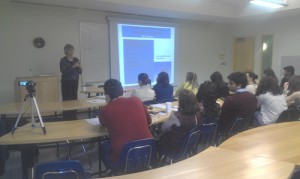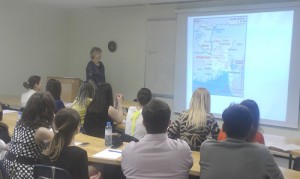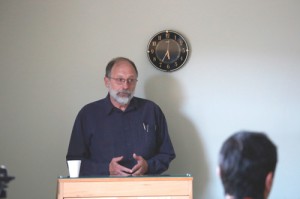The AUA School of Public Health organized a Seminar Series on the impact of the global economy on the health of communities through examples of toxic tanneries in Bangladesh and heavy metal poisoning worldwide.
On April 14, Dr. Margrit von Braun presented “Toxic tanneries.” Most of the world’s leather is manufactured in the tanneries of Hazaribagh, a slum in Old Dhaka, Bangladesh and considered to be one of the most polluted places on Earth. The tanneries have no wastewater treatment, are largely unregulated and employ 15,000 people including many children. This seminar discussed efforts to address the environmental pollution and unsafe working conditions based on a March 2014 site visit by the TerraGraphics International Foundation (TIFO) with Doctors without Borders (MSF).
See the video here
On April 15, Dr. Ian von Lindern presented “Escalating community metals poisoning due to changes in the global economy.” Dr. von Lindern discussed how the review of metal markets over the last 50 years reveals high prices leading to risky and ill-advised behavior, resulting in large numbers of poisoned workers and communities. From the environmental health perspective, damage associated with mining and smelting is largely in proportion to safeguards countries have in place. In the last two decades, much of polluting activities associated with minerals production has shifted from high-income countries to low- and middle-income countries, resulting in some of the worst incidents of community metals poisoning in history. In 2010 in northern Nigeria, the international NGO Médecins Sans Frontières discovered the world’s worst lead poisoning epidemic in remote villages where residents were mining for gold. More than 17,000 people were severely poisoned and 400-500 children died in six months. Several international organizations collaborated with Nigerian health authorities, and local civil and traditional governments in providing emergency medical, environmental, technical, and public health response.
See the video here
AUA School of Public Health students, alumni, researchers, and faculty, representatives of health and environmental NGOs attended the two seminars and had active discussions with the experts.
Dr. Margrit von Braun is an environmental engineer with degrees from the Georgia Institute of Technology (B.S.), the University of Idaho (MCE), and Washington State University (PhD). She is a licensed Professional Engineer. Her teaching and research has been in the area of hazardous waste management and risk assessment. She helped found and directed the Environmental Science and Environmental Engineering programs at the University of Idaho (UI) from 1993-2003; served as Dean of the College of Graduate Studies for nearly 10 years before retiring in 2010, and was the Acting Vice President for Research and Graduate Studies UI in 2003. Dr. von Braun is co-founder of TerraGraphics International Foundation (TIFO) and TerraGraphics Environmental Engineering, Inc. Dr. von Braun received a 3-year leadership development fellowship from the W. K. Kellogg Foundation, the Outstanding Faculty Award from the College of Engineering and the Graduate Teaching Excellence Award. She was elected to the UI Academy of Engineers. She has served as President of the Western Area Graduate Schools. In 2012, Dr. von Braun was elected as a Fellow of the Collegium Ramazzini.
Dr. Ian von Lindern holds a B.S. in Chemical Engineering from Carnegie-Mellon University and M.S. and Ph.D. degrees in Environmental Science and Engineering from Yale University. Dr. von Lindern is co-founder of TerraGraphics International Foundation (TIFO), a non-governmental organization that specializes in reducing human health risks in developing countries associated with exposure to environmental contaminants. TIFO assisted the Nigerian governments in designing and implementing the largest lead health cleanup yet undertaken in a low-income country. The project was modeled on U.S. Environmental Protection Agency (USEPA) “Superfund” protocols adapted to the local cultural and socio-economic system and technical capabilities. He has 40 years of experience in human health risk assessment and environmental remediation and has led five international cleanup projects in China, Russia, Dominican Republic, Senegal, and Zamfara, Nigeria. The work has been recognized with United Nation Environment Program (UNEP) GreenStar Award for outstanding humanitarian services and Distinguished Alumnus Award from the Yale University School of Forestry and Environmental Studies. Dr. von Lindern serves on the U.S. EPA Science Advisory Board (SAB), reviewing the scientific basis for lead regulatory policy for the U.S.
The AUA School of Public Health works actively to improve the health of the populace and health services in Armenia and the region through interdisciplinary education and development of public health professionals and others to be leaders in public health, health services research and evaluation, and health care delivery and management.
 
Dr. Margrit von Braun’s seminar |
 
Dr. Ian von Lindern’s seminar |
